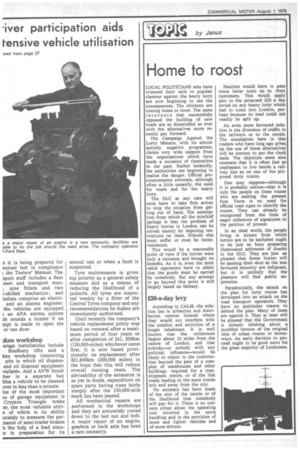Home to roost
Page 30

If you've noticed an error in this article please click here to report it so we can fix it.
LOCAL POLITICIANS who have trimmed their sails to popular clamour against the heavy lorry are now beginning to see the consequences. The chickens are coming home to roost. The same int crest s that successfully opposed the building of new roads are as dissatisfied as ever with the alternatives more recently put forward.
The Campaign Against the Lorry Menace, with its almost entirely negative programme, claims very wide support from the organisations which have made a nuisance of themselves in the past. Rather 'belatedly, the authorities are beginning to realise the danger.. Official pronouncements reiterate, although often a little uneasily, the need for roads and for the heavy lorry.
The GLC at any rate will soon have to take firm action to stop the situation from getting out of 'hand. The assumption from which all the mischief springs is that the problem of heavy lorries in London can be solved merely by imposing restrictions on them. Nobody else must suffer or even be inconvenienced.
This would be a reasonable point of view if the lorries were only a nuisance and brought no benefits. As it is, even the most rabid opponents have to admit that the goods must be carried by somebody. But any attempt to go beyond this point is still largely based an fantasy.
£30-a-day levy
According to CALM, the solution lies in collection and distribution centres located where they would not 'interfere with the comfort and activities of a single inhabitant. It is well known that the wilderness begins about 15 miles from the centre of London, and that nobody—or nobody with any political influence—would be likely to object to the construction beyond the pale of a complex of warehouses and other buildings required for a transhipment centre, or of the link roads leading to the main routes into and away from the city.
No estimate has been made of the cost of the centre or of the likelihood that somebody will pay for it. There is no concern either about the operating cost involved in the extra handling and in the provision of more and lighter vehicles and of more drivers. Hauliers would have to pass these latter costs on to their customers. This would apply' also to the proposed £30 a day levied on any heavy lorry which had to come into London, perhaps because its load could not readily be split up.
An even more favoured solution is the diversion of traffic to the railways or to the canals. The assumption here is that traders who have long ago given up the use of these alternatives will be content to put the clock back. The objectors seem also unaware that it is often just as unpleasant to live beside a railway line as on one of the proposed lorry routes.
One may suppose—although it is probably untrue—that it is only the people on these routes who are making the present fuss. There is no need for official road signs to identify the routes. They can already be recognised from the lines of eager collectors of signatures to the petition of protest.
In an ideal world, the people living in streets from which lorries are to be excluded ought to be just as busy preparing illuminated addresses of thanks to the GLC. They are just as pleased that fewer lorries will be passing their door as the less favoured minority are indignant, but it is unlikely that the pleasure will find public expression.
Paradoxically, the attack on the plan for lorry routes has developed into an attack on the road transport operators. They have no particular reason to defend •the plan. Many of them are against it. They at least will be pleased that the Government is already 'thinking about a modified version of the original idea of urban routes or motorways. An early decision to proceed ought to be good news for the great majority of Londoners.




















































































